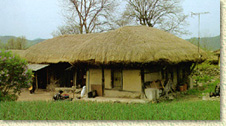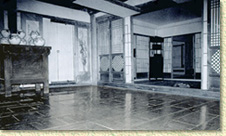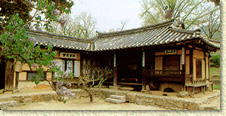
|
traditional house A Korean house is built with a rooms and a big wooden floor in the center. Houses from other lands are usually simple frame houses but they have either rooms only, or just a wooden floor. In Northern regions houses are closed private homes called "umjib" and in Southern regions houses are open and are in a hut-like form. You can easily spot traditional houses in Kahwaedong. It used to be a wealthy district where aristocrats used to live. explore and be amazed how this traditional site can be situated along with modernized buildings. |

|
wooden floor (maru)
The wooden floor was made to store grains and link rooms. It was also used as a place of sacrificial ancestral worship. |
|
To avoid the humidity and heat during the summer, the wooden floor is made so it doesnt
touch the ground. So it helps ventilation in the house. It is not known exactly why and how
the "maru" came to be, but scholars say it was to prevent the heat in southern areas of
Korea. Its key use was to help ventilate the house.
|

|
Under-floor heating system (Ondol)
Made by putting mud over under-floor heating stones, "ondol" is a main feature of traditional Korean houses. If lighted on the morning and evening, it witheld a pleasant l5 degree Celcius. This shows that the "ondol" system is quite based on scientific terms. These days steam heating is used more than 'ondol'. |
tile roof (kiwa)

|

|
If you look closely at Korea's roofs, you'll see the no roofs are flat. Almost all are in shapes
of curved lines and surfaces. The curves of the roof shows the originality of Korean
architecture. It is not known when tiles were first used.
Before using tiles (kiwa) people had used plates of wood and bark but most were covered with bundles of grass.
|
|
The tiles were made so the roofs could be slanted and was useless in making flat roofs. If
the angle of the roof was exact, it was easier to drain away rain water. The size and shape
of the tiles affected the angle of the roof and the angle is determined by the weather
conditions of a cenain region.
The kiwas or tiles, were made of clay from the rice paddy fields. Different shapes and sizes were used for each different places of the roof.
|
 |
 |
 |
